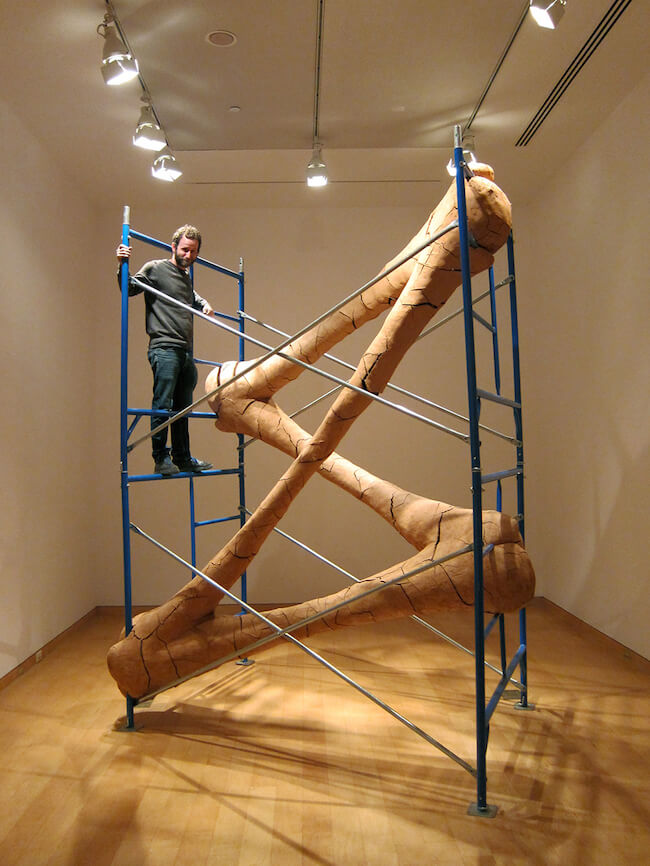We recently saw David Katz’s work scattered around this year’s NCECA conference including at UMass Dartmouth, where he completed a Post-Baccalaureate program in 2009, in the exhibition The Uncommon Object. Katz graduated from the University of Indiana-Bloomington with an MFA in 2012 where he also taught as an Associate Instructor of Ceramics. He is currently the Ceramic Technician and Visiting Artist at Bennington College in Vermont.
Above image: David Katz
Katz creates site-specific installations that stretch biomorphic dry clay across rooms and galleries. The clay is unfired and cracks as it dries giving a sense of extreme fragility and leaves you wondering, “How is that still suspended there?” The dried slime is secured to metal-looking anchors placed around the space. The goo grabs them firmly, but gently, like a hand on your back, loving and reassuring, but dominant, a reminder that you can be pushed to the ground. The goo is a killer substance in hibernation until naively awoken by the human race who will swiftly be suffocated, one-by-one. There is an adrenaline rush in being near Katz’s installations, so close to death. Not your typical death, something worse, a complete elimination from history, a lack of existence.
“Through my installations I explore the notion of existence within a fabricated reality of constructed space…” “While most species evolve by adapting to local ecosystems and environments, humans uniquely alter the environment to fit our needs. As a result, we exist within realities of our own construction, adapting to a world of our own creation.”

David Katz, Numerical Order (detail), 2013
There is an irony in Katz’s biomorphic installations, where they are commenting on human created systems by mimicking the very process of creating them. Like humans, Katz finds a space, imposes his sculpture into it and then visualizes time passing through the clay drying and cracking. They create an experience of looking at a huge amount of time (past, and yet-to-come) in a single instant – fossils from the future.
Katz’s site-specific installation at Arch Contemporary titled Contingent Crib was a departure from his typical biomorphic goo work, taking a different approach to addressing similar ideas of constructed systems. Here, Katz took an existing system, a corn crib, the oldest farm structure on the Sakonnet Peninsula in Rhode Island, and made a sculptural addition, an unfired clay “inflated pedestal” around its foundation. Rather than designing the entire system, like in his previous work, Katz took an actual system that had run its course, and used it as a vehicle to explore history, importance, and location. Observing the commonalities between this piece and his biomorphic work reveals what is at the heart of Katz’s practice.

David Katz, Confinement Trio, 2011, 36 x 18 x 6 inches
“My hope is to create installations that explore human tendencies of colonization, expansion, and emergence of order, while allowing the material nature of clay to expose questions of permanence and sustainability.”
In Contingent Crib the irony of Katz’s system-mimicking biomorphic sculpture is absent, working with literal time and history as the framework for the piece, not a representation of it. Both are interesting approaches to arrive at similar questions, but Contingent Crib contained a vitality that is sometimes lost in his biomorphic work. There, risk was present, along with imperfection, vagueness, subtly, tension, realism, and mystery, all things that gave the unsuspecting structure a profound presence and modern day relevance.
What do you think of Katz’s biomorphic sculptures and his Contingent Crib piece at NCECA? Let us know in the comments.
Justin Crowe is Writer-at-Large for CFile.

David Katz, Numeric Constraint




David Katz, Every Which Way, 2014 at the Space Lab Gallery

David Katz, Numerical Order, 2013 at the Art League Houston

David Katz, Mediated Landscape, 2012

David Katz, Mediated Landscape (detail), 2012

David Katz, Claiming Boundaries, 2011

David Katz, Contingent Crib, 2015

David Katz, Contingent Crib (detail), 2015

Nice work, nice review, Justin. Thanks.
Great work – someone to watch